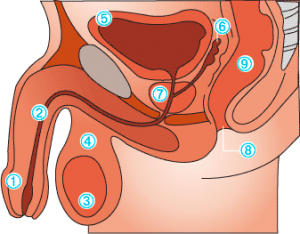Anatomy of the prostate
The prostate is a small gland in the male reproductive system. It is situated in front of the rectum, below the bladder, and surrounds the urethra, which is the tube through which urine flows out of the body. The main function of the chestnut-sized prostate is to secrete part of the seminal fluid that combines with sperm to form semen.
A healthy adult prostate weighs around 20 to 25 grams and is approximately 4cm wide, 3cm high and 2cm thick.

- Penis
- Urethra
- Testis
- Scrotum
- Bladder
- Seminal vesicle
- Prostate gland
- Anus
- Rectum
Prostate scheme
Diseases of the prostate
Prostatitis
The term prostatitis – or prostate infection – refers to a swelling of the prostate that usually occurs after the age of 40. The disease causes urinary symptoms (frequent urge to urinate, burning sensation, intermittent urination, etc.), and may also cause lower abdominal pain and fever. Prostatitis is treated with antibiotics.
Adenoma
The constituent tissue of the prostate may become hypertrophied (i.e. abnormally over-developed) with age. This phenomenon is known as prostate adenoma or benign prostate hyperplasia (BPH). This is a benign disease, not cancer, but it often goes undiagnosed until it causes discomfort and/or painful urination. Prostatic adenoma causes urinary disorders because it develops around the urethra, which is the tube through which urine flows from the bladder to the exterior. The symptoms are the result of the adenoma compressing the urethra.
Prostate cancer
The human body is made up of cells that divide and reproduce throughout our lives. Sometimes, new cells may contain a defect. Cancer occurs when these cells in turn reproduce, creating more and more abnormal malignant cells. Prostate cancer is the fourth most common cancer in both sexes combined and the second most cancer in men, with 1.1 million new cases diagnosed in 2012 around the world (1 111 689 cases identified in 2012 according to the World Cancer Report 2014*). However, because prostate cancer is a slow-developing disease that tends to affect older men, fatality rates directly attributable to the disease are reasonably low. With an estimated 307,000 deaths in 2012**, prostate cancer is the fifth leading cause of death from cancer in men (6.6% of the total men deaths).
*: ©International Agency for Research on Cancer, 2014 – World Cancer Report
**:©GLOBOCAN 2012 (IARC) , Section of Cancer Surveillance (13/3/2017)
Prostate cancer often develops without any symptoms and in many cases is diagnosed at an early stage by screening. Cancer may also be diagnosed at a later stage, when the patient reports symptoms such as a frequent urge to urinate, difficulty urinating or painful ejaculations. As these symptoms are the same as for prostatic adenoma, several examinations are necessary in order to reliably diagnose cancer.
Prostate cancer risk factors
- Age
- Hereditary factors
- Ethnic origin
- Fatty diet
- Other factors: sedentary lifestyle, obesity, etc.
